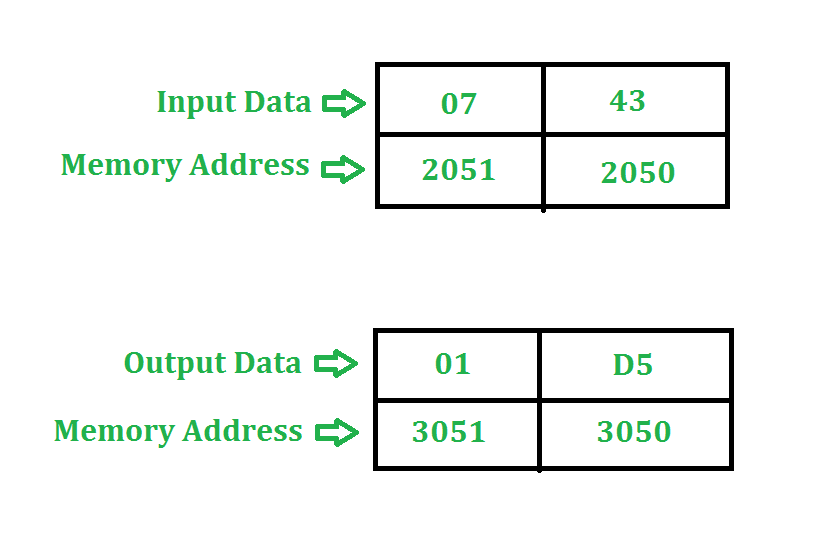8085 program to multiply two 8 bit numbers
Last Updated :
11 Apr, 2023
Problem – Multiply two 8 bit numbers stored at address 2050 and 2051. Result is stored at address 3050 and 3051. Starting address of program is taken as 2000.
Example –

Algorithm –
- We are taking adding the number 43 seven(7) times in this example.
- As the multiplication of two 8 bit numbers can be maximum of 16 bits so we need register pair to store the result.
Program –
| Memory Address |
Mnemonics |
Comment |
| 2000 |
LHLD 2050 |
H←2051, L←2050 |
| 2003 |
XCHG |
H↔D, L↔E |
| 2004 |
MOV C, D |
C←D |
| 2005 |
MVI D 00 |
D←00 |
| 2007 |
LXI H 0000 |
H←00, L←00 |
| 200A |
DAD D |
HL←HL+DE |
| 200B |
DCR C |
C←C-1 |
| 200C |
JNZ 200A |
If Zero Flag !=0, goto 200A |
| 200F |
SHLD 3050 |
H→3051, L→3050 |
| 2012 |
HLT |
|
Explanation – Registers used: A, H, L, C, D, E
- LHLD 2050 loads content of 2051 in H and content of 2050 in L
- XCHG exchanges contents of H with D and contents of L with E
- MOV C, D copies content of D in C
- MVI D 00 assigns 00 to D
- LXI H 0000 assigns 00 to H and 00 to L
- DAD D adds HL and DE and assigns the result to HL
- DCR C decrements C by 1
- JNZ 200A jumps program counter to 200A if zero flag != 0 (Not equal to 0)
- SHLD stores value of H at memory location 3051 and L at 3050
- HLT stops executing the program and halts any further execution
Read next: Assembly language program (8085 microprocessor) to add two 8 bit numbers
Another approach:
We can do multiplication of two 8-bit numbers without using DAD and XCHG command.
Program-
| ADDRESS |
MNEMONICS |
COMMENT |
| 2000 |
LXI H, 2050H |
|
| 2003 |
MOV B, M |
B←M |
| 2004 |
INX H |
|
| 2005 |
MOV C, M |
C←M |
| 2006 |
MVI A, 00H |
A←00 |
| 2008 |
TOP:ADD B |
A<-A+B |
| 2009 |
DCR C |
C←C-1 |
| 200A |
JNZ TOP |
|
| 200D |
INX H |
|
| 200E |
MOV M, A |
M←A |
| 200F |
HLT |
terminate the program |
Explanation –Registers A, H, L, C, B are used for general purpose.
1. LXI H, 2050 will load the HL pair register with the address 2050 of memory location.
2. MOV B, M copies the content of memory into register B.
3. INX H will increment the address of HL pair by one and make it 2051H.
4. MOV C,M copies the content of memory into register C.
5. MVI A,00H assign 00 to A.
6. top: ADD B add the content of accumulator with register B and store the result in accumulator.
7. DCR C decrement the register C.
8. JNZ TOP jumps on top till C doesn’t becomes 0.
9. INX H will increment the address of HL pair by one and make it 2052H.
10. MOV M,A copies the content of A which is our answer to register M.
11. HLT stops executing the program and halts any further execution.
Advantages:
- The program is a simple and efficient way to multiply two 8-bit numbers using the 8085 microprocessor.
- The program uses only a few instructions and requires minimal memory space, making it easy to implement in a microcontroller.
- The program produces accurate results since it performs a series of repetitive additions to calculate the product.
- The program can be easily modified to multiply larger or smaller numbers by changing the memory addresses.
Disadvantages:
- The program is computationally intensive and time-consuming since it requires a series of repetitive additions to calculate the product.
- The program is not very efficient in terms of memory usage since it requires several registers to store the operands and intermediate results.
- The program is not very scalable since it requires a large number of iterations to multiply large numbers, which may cause overflow or underflow conditions.
- The program does not provide any error checking or reporting mechanism, which may make it difficult to identify errors or faults in the program.
Like Article
Suggest improvement
Share your thoughts in the comments
Please Login to comment...